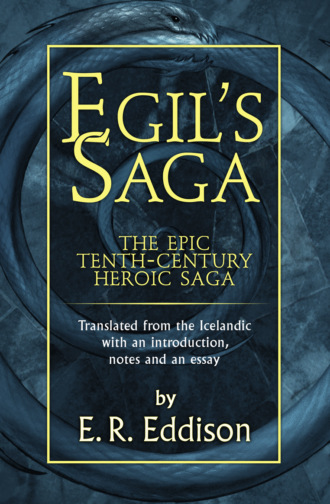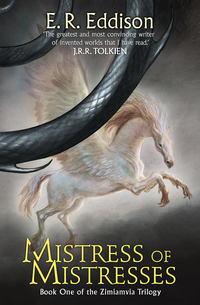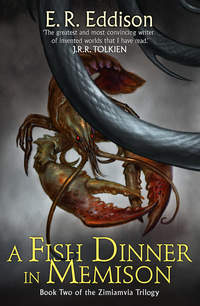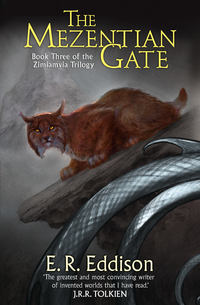
Полная версия
Egil’s Saga
The priest’s neighbours and dependants were called his ‘thingmen’, because they followed him to the Thing or parliament, where laws were made and suits tried. The Thorsness Thing was the first of these assemblies. Later, in 930, the Althing was established in the south-west beyond Mossfellsheath, as the annual meeting-place for all Iceland. It is said that a man named Grim Goatshoe travelled all over Iceland to find the best place for the Althing, “and every man in the land here brought him a penny for it; but he gave that fee afterward to the tempie”. The place was chosen, no doubt, for its accessibility, but it was fitted too by its grandeur to be the seat of the hallowed Thing: the quiet lake, the three-mile black lava rampart of the Almannagjà, or Great Rift, over which the little river Axewater falls and thunders, the level water-meadows and green slopes where the chiefs had their booths, set about with lava-fields torn with profound rifts and chasms, the circling mountains. It is a remarkable evidence of the political and legal instinct which co-existed in the Icelandic mind along with its intense individualism, that for hundreds of years every man of any account in Iceland rode to this place yearly; a journey, from some parts of the country, not of days but of weeks.
This, then, was the Icelandic commonwealth: scattered communities, each owing a loose allegiance to its chief or temple-priest, held together by the bond of race and the yearly meetings of the Althing. The Icelanders had come from Norway because they were minded to be their own masters, and in no other civilized community has there been greater freedom of the individual. There was no executive government: the enforcement of the law rested, in the last resort, on private vengeance. Nor (in theory, at any rate) was the bond of priest and thingman more than a matter of honourable contract between free men, which could be terminated at will by either party. The safety of the republic lay in its physical conditions: in the absence of external aggression, and the great distances within the land. This anarchy succeeded, it is to be noted, only so long as it was not put to the strain; only so long as great men were content to be great each in his own countryside, so long as the ties of kinship remained sacred, and so long as there was wide room for all.
When these conditions were broken, the whole polity went to wreck. In the thirteenth century powerful men began to collect priesthoods, to stretch out grasping hands beyond their own confines, and aspire, like the brilliant young Sturla Sighvatson, to political supremacy and dominion. The house of the Sturlungs shadowed half the country with their power; then split and quarrelled among themselves: marched with armies to pitched battles on a scale that was not dreamed of in the old days. Those battles were ruinous out of all proportion to their casualty lists, for it was the great men who fought to the death while their followers were given peace. The life-blood of the land was thus let out in the bitterness of civil war. Norway, that had long in these later years watched and intrigued and waited, stepped in at last. If a moment should be fixed for the passing away of the Icelandic republic, it might fitly be the night of the 22nd September, 1241, when Snorri Sturlason, historian and politician, youngest and most famous of the three Sturlung brothers, was stabbed to death in his house at Reykholt by murderers hired by his own son-in-law at the setting on of the King of Norway.
* I.e. the Hebrides.
† For List of Abbreviations.
* A ceremony to show that henceforth the land belonged to him.
THE GODS
The reader who wishes to inform himself more closely of the character of the old Northern religion, the faith brought by the settlers to Iceland, cannot do better than turn to the ancient mythical and didactic poems of the Elder Edda such as the Völospá, the Hávamál, Grimnismál, etc., in Vigfusson and York Powell’s translations, C.P.B. vol. 1, and to the chapter by Dame Bertha Phillpotts on ‘Germanic Heathenism’ in vol. 11 of the Cambridge Medieval History, and Professor Chadwick’s chapter on the old religion in his Heroic Age (Cambridge University Press). I would also refer him, were it available in English, to the brilliant monograph lately published by Professor Nordal on The faith of Egil Skallagrimson based on the evidence of the Sonatorrek.
Explicitly, there is very little about religion in the sagas. What there is, seems to show that in Iceland Thor was more widely worshipped than any other God, and after Him, Frey. Out of every five settlers, one has a name beginning with ‘Þór’. It is recorded that when the Northmen came to Iceland they found there some Irish hermits who “afterwards went away because they would not be here with heathen men”.*
There was among the settlers a small leaven of Christianity: e.g. Queen Aud, who settled Laxriverdale, was a Christian. But this quickly died out. Taking all the evidence into account, it is fair to conclude that even among its avowed adherents Christianity had as yet struck no deep roots. Of such adherents the famous settler Helgi the Lean is probably a fair example: “He was much mixed in his faith: he trowed on Christ and named his homestead after Him; and yet called he upon Thor on sea voyages and in hard occasions, and in all things whereso he thought most rested on it” (Landn). This independence of attitude is, indeed, characteristic. We see it in Egil himself, in the Sonatorrek, where he not only expresses a desire to be given a chance of punishing Aegir, the God of the sea, for the destruction of his son, but says he has a mind to give over worshipping Odin Himself because He has broken faith with him and cast him off. The same mind is shown in Hrafnkel Frey’s-priest, a mighty lord in the east country, who let build a great temple and loved no other God more than Frey, and gave “his friend Frey” a half share in his horse Freyfaxi, that he thought better than any other treasure he had; but, fallen on evil days and reft of horse and honour, said: “I account that foolery, to trow in Gods”; and kept his word, and made no more blood-offerings, but in due time had vengeance on his foes and won back all his lordship (Hrafnkel’s Saga). Also, in Sigmund Brestison of the Faereys, who, when the great Earl Hakon asked him in what God did he most trust, answered and said, “I put my trust in my own might and main” (Færeyinga Saga, ch. 23). In the same way Thorolf Mostbeard, in a passage already quoted (Eb. 4), is “a great friend” of Thor.
Of a future life the conceptions do not appear to have been settled. The trend of opinion is in favour of the view that the Eddie religion of Odin and Valhalla was by no means universally entertained in the North: it may have been as ancient, probably more ancient, than the cult of Thor, but it was pre-eminently a religion of kings and vikings. That Egil himself worshipped Odin is clear from the Sonatorrek: but there are reasons for thinking that it may have been an acquired religion in his case, not the religion to which he was brought up from birth. That Bodvar had, as Egil believed, gone to Valhalla, seems clear from the references to “the way of bliss” and “the bee’s path” in the 10th and 18th staves of the Sonatorrek. Odin and His Hall of the Slain, where the lordly dead carouse after fight, having for cup-maids the Valkyries of the Lord of Hosts: these things are far off, away from “middle-earth” (Miðgarðr). But Thorolf Mostbeard believed that when he died he should fare into Holyfell, the little steep basaltic hill that stands abruptly up in the midst of the Thorsness peninsula, “and all his kindred from the ness” (Eb. 4); and the night that his son, Thorstein Codbiter, was drowned in Broadfirth fishing, his shepherd saw how Holyfell “was opened in the north side, and in the fell he saw mighty fires, and heard huge clamour therein, and the clank of drinking-horns; and when he hearkened if perchance he might hear any words clear of others, he heard that there was welcomed Thorstein Codbiter and his crew, and he was bidden to sit in the high-seat over against his father” (ibid. 11). In the same way, Gunnar of Lithend was thought to have ‘died into’ his howe. The neat-herd and the serving maid were driving cattle, and “they thought that he (Gunnar) was merry, and that he was singing inside the cairn”. Another night, Skarphedinn and Hogni “were out of doors one evening by Gunnar’s cairn on the south side. The moon and stars were shining clear and bright, but every now and then the clouds drove over them. Then all at once they thought they saw the cairn standing open, and lo, Gunnar had turned himself in the cairn and looked at the moon. They thought they saw four lights burning in the cairn, and none of them threw a shadow. They saw that Gunnar was merry, and he wore a joyful face. He sang a song…After that the cairn was shut up again” (Nj. 77). There are many other instances of this belief of ‘dying into howes’. There are also cases, throughout the old literature, of ‘howe-dwellers’: ghosts, but of no thin astral substance: rather, solid, strong and violent ghosts, ‘undead’ like the mediaeval vampire, who walk abroad, ride the roofs, and slay men and cattle. A locus classicus is the dead shepherd Glam, in Grettla. It was against such walkings that precautions were taken such as those described in ch. LVIII of our saga (see note ad loc.), and in Eb. 33, 34.
Christianity was ‘brought into the law’ in the year A.D. 1000 It is clear from the accounts given in the sagas (and this is confirmed by more general considerations referred to below) that the change of faith was primarily and in substance a political proceeding based on considerations of expediency rather than on any religious movement among the people. As soon as it became plain, at the famous meeting of the Althing in the year 1000, that religious controversy was about to split the commonwealth from top to bottom, men turned to seek an expedient that should avoid the evil of two laws in the land. Snorri the Priest was the main actor here, and by his persuasion both sides were brought to lay the matter in the hands of Thorgeir the Priest of Lightwater, who was then Speaker of the Law. Thorgeir’s award made Christianity the law, and forbade (on pain of outlawry) heathen rites and the exposure of children: but the old worship, though forbidden in public, was to be allowed in private. It is characteristic that this statesmanlike compromise, which brought Christianity into the law and preserved the cohesion of the state, was dictated by a heathen. Henceforth, though the letter of the law was Christian, the pagan spirit lived on. Its persistence, many generations after the ‘change of faith’, is seen in the persistence of the old ways of life. Christian bishops practised polygamy and rode on raiding expeditions in the Sturlung days as freely as the great men of old. Hallfred the Troublous-skald wore his new faith so lightly that his readiest threat was to cast it off and be a heathen again if the King would not listen to his poem. But perhaps the most striking evidence of the abiding life of the pagan spirit is the impartiality and lack of Christian colouring in the sagas themselves; for in no country has Christianity been a tolerant religion. In Egla, which was probably written down in final form about the middle of the thirteenth century, it is hard to find a phrase or turn of speech which betrays the point of view of a Christian telling a story of old heathen times, or which is out of tune with the mind and temper of Egil’s own generation and the heroic age.
The two essential facts about the old faith which stand out clearly amid much that is doubtful and obscure are, first, its fatalism, and secondly, the relation of fellowship between men and the Gods.
Fatalism is in the deep foundations of the old Northern mythology. Beyond death, beyond the joys of Valhalla, looms the shadow of Ragnarok—of that Dies Iræ, when the Wolf shall be loosed and Midgard’s Worm shall come, and heaven and earth and the blessed Gods themselves shall pass away in catastrophic ruin. The terrors of that Day are foretold in one of the grandest of the Eddic poems, the Völospá, from which, to show the spirit of doom and desolation that informs the ultimate things in this creed, I will quote some verses, beginning with the crowing of the cocks in the three worlds to usher in the “One fight more—the best and the last”:
Sate on the howe there and strake harp-string
The Grim Wife’s herdsman, glad Eggthér.
Crow’d mid the cocks in Cackle-spinney
A fair-red cock who Fialàr hight.
Crowéd in Asgarth Comb-o’-Gold,
Fighters to wake for the Father of Hosts.
But another croweth to Earth from under:
A soot-red cock from the courts of Hell.—
Garm bayeth ghastful at Gnipa’s cave:
The fast must be loos’d and the Wolf fare free.
Things forgot know I, yea, and far things to come:
The Twilight of the Gods; the grave of Them that conquer’d.
Brother shall fight with brother, and to bane be turnéd:
Sisters’ offspring shall spill the bands of kin.
Hard ’tis with the world: of whoredom mickle:
An axe age, a sword age: shields shall be cloven;
A wind age, a wolf age, ere the world’s age founder.
Mimir’s children are astir: the Judge up standeth,
Even with the roar of the Horn of Roaring.
High bloweth Heimdall: the Horn is aloft;
And Odin muttereth with Mimir’s head.
Shuddereth Yggdrasill’s Ash on high,
The old Tree groaneth, and the Titans are unchain’d.—
Garm bayeth ghastful at Gnipa’s cave:
The fast must be loos’d and the Wolf fare free.
What aileth the Aesir? What aileth the Elves?
Thundereth all Jotunheim: the Aesir go to Thing.
The Dwarf-kind wail afore their doors of stone,
The rock-walls’ warders.—Wist ye yet, or what?
Hrym driveth from the east, holdeth shield on high.
Jormungand twisteth in Titan fury.
The Worm heaveth up the seas: screameth the Eagle:
Slitteth corpses Neb-pale: Nail-fare saileth.
A Keel fareth from the west: come must Muspell’s
Legions aboard of her, and Loki steereth.
Fare the evil wights with the Wolf all;
Amidst them is Byleist’s brother in their faring.
Surt from the south cometh, switch-bane in hand;
Blazeth the sun from the sword of the Death-God:
The granite cliffs ciash, and the great gulfs sunder;
The Hell-dead walk the way of Hell, and the Heavens are riven.
It is against this gloomy background of fatalism and foredoom that the men and women of the sagas play out their lives. This, like a thick black shadow of darkness, shadows their every word and deed, yet leaves them proud, and practical, and unafraid. Count Hermann Keyserling has said, with profound insight, that the belief in predestination is always grandiose in effect where its disciples possess proud souls. And he speaks of the fatalism of Islam in words that might have been spoken of the Northmen: “The fatalism of the Moslem, like that of the original Calvinist, and in contradiction to that of the Russian, is the expression not of weakness but of strength. He neither trembles before the terrible God in whom he believes, nor does he hope for His particular benevolence, nor does he suffer himself to be driven at will by fate: he stands there, proud and inwardly free, opposite to the Superior Power, facing eternity with the same equanimity as he faces death”.* Such a mind we see everywhere in the sagas: in the terrible Skarphedinn when, before the burning of Bergthorsknoll, he chooses the hazard of defending the house rather than fight in the open in disobedience to his aged father: “I may well humour my father in this, by being burnt indoors along with him, for I am not afraid of my death” (Nj. 127); in Kiartan, sending back his company and riding with but two followers on his last ride southward towards Laxriverdale (Ld. 48); and, in our own saga, in old Kveldulf watching the fate he from the first foreboded step by step draw nearer to his son.
Of the sense of fellowship with the Gods I have already quoted instances. The nobility of this attitude of mind is well caught by Stevenson in one of his little febles, of the priest, the virtuous person, and the old rover with his axe: “At last one came running, and told them all was lost: that the powers of darkness had besieged the Heavenly Mansions, that Odin was to die, and evil triumph.
“‘I have been grossly deceived’, cried the virtuous person.
“‘All is lost now’, said the priest.
“‘I wonder if it is too late to make it up with the devil?’ said the virtuous person.
“‘O, I hope not’, said the priest. ‘And at any rate we can but try.—But what are you doing with your axe?’ says he to the rover.
“‘I am off to die with Odin’, said the rover.”*
This proud pagan spirit of fatalism and fellowship with, not subservience to, the ultimate Power, is implicit throughout the saga literature. It is, in my judgement, the deep underlying rock on which the greatness of that literature, as an expression of much that is finest and noblest in the human spirit, is founded and built.
* Ari, Libellus Islandorum, ch. 1. Cf. Landn.
* The Travel Diary of a Philosopher, Part III, ch. 26 (Jonathan Cape).
* The Works of Robert Louis Stevenson: Tales and Fantasies, vol. IV, p. 372, Edinburgh, 1897.
THE SAGA
So much for the foundations. The building itself is before our eyes in one of its most characteristic elevations, in the shape of Egil’s Saga. Here I will not waste time on trying to say more briefly what has been said, rightly and once and for all, by the late W. P. Ker in his masterpiece of inspired criticism, Epic and Romance. To complete our background, however, it may be useful to note a few of the salient features of that peculiar form of prose narrative which is Iceland’s contribution to the creative literature of the world.
A saga may be roughly defined as a prose narrative which deals dramatically with historical material, and in which the interest is concentrated upon individual persons, their characters, actions, and destinies. Rough as it is, this definition will serve to indicate distinctions between the Icelandic prose epic and the products of other countries and other ages. A glance at some of these distinctions may be the readiest way towards an appreciation of what a saga essentially is.
The saga is like Homer in that it is heroic in matter and in spirit: it is unlike, in that it is prose, not poetry; that its interest is more purely individual (the epic opposition of Trojan and Greek has no counterpart in the sagas: how far removed are the two attitudes is seen if we contrast the treatment of that opposition by Homer with the treatment in Egla of the opposition of the King and the great houses); that it eschews the supernatural and the marvellous, whereas the Gods in the Iliad are ever present, often as protagonists in the action, and the Odyssey is packed with magic, monsters, portents, and supernatural beings. Moreover, swift as is the movement of Homer, the action pauses continually for the introduction of poetic ornament, simile or description. The action of the saga never pauses except for the introduction of genealogical information.
The historical books of the Old Testament are, save in the single circumstance of their being prose and not poetry, still further removed from the saga. Their outlook is national and theocratic in a far higher degree than Homer’s. French Romance, again, is epically national (Christendom against the Paynim), and abounds in miracles and marvels; besides this, it presents other qualities which distinguish it sharply from the saga: its historical basis is generally flimsy, and, which is more important, history is to it not an end in itself but a framework for fancy’s most rich and unrestrained embroidery; its characters are types, not individuals; its main interest, wild and strange adventure in a dreamland of chivalry and romantic love; its method, formless and luxuriantly meandering. The heroic tales of Keltic tradition, apart from the varying but always large part played in them by the mythical element, differ from the sagas more fundamentally than do even the Romances of chivalry. This is because the old Keltic heroic story is in its processes the direct opposite of the Icelandic; the instinctive idiom and figure of the one is rhetoric and hyperbole; of the other restraint and meiosis. Thus words and phrases to the Kelt, in his great scenes, are material to be poured out in a spate of eloquent emotion; in the saga, on the contrary, the expression becomes more tense and curbed as the situation heightens, until words and phrases have effect individually and apocalyptically like lightning flashes, each trailing behind it (for in this method the effect often depends less on what is said than on what is left unsaid) a turmoil of associations like rolling thunders.
There are two more masterpieces of prose narrative which we may profitably contrast with the sagas: the Arabian Nights, in which the action is slowed down to give leisure for the luxurious contemplation of every form of sensuous beauty; and Boccaccio’s Decameron, in which, on the whole, plot and situation outweigh character. By the beauty of nature* the Northman (if we may judge from the sagas) set little store: by physical beauty in man and woman he set much, but was content to note it in his terse objective way, “the fairest of men to look on”, seldom going into detail and never permitting it to interrupt the stride of his story. The sagas abound in dramatic situations, but they rarely excel in plot. But the briefest consideration of, for example, Njála or the little saga of Hrafnkel Frey’s-priest, both of which are masterpieces of plot-construction, is enough to show that the plot depends for its whole life and power upon the personalities of its actors: upon Njal, Skarphedinn, Flosi and Kari and a host of living, if minor, characters in the one case, and upon Hrafnkel and Sam in the other. And we need but call to mind any great scene, such as Njal’s burning or (in our own saga) the Höfuðlausn scene in York, to see how the whole art of dramatic situation, suspension, irony, clash of motives and of wills, and every circumstance of tragic grandeur is bent to the singlepurpose of conjuring up in living reality individual men and women without whom the situation would be left meaningless or commonplace: Eric and Arinbiorn, Egil and Gunnhild.
We have not yet looked at the modern novel, nor, for that matter, at the Elizabethan drama. Here at least is to be found that preoccupation with individual character for which we have so far found no parallel outside the sagas: Squire Western, Becky Sharp, Victor Radnor, Diana of the Crossways, Nevil Beauchamp; Beatrice in Much Ado, Falstaff, Othello, Hamlet, Cleopatra, Vittoria Corombona, Bosola, Flamineo, Brachiano. On the whole, Shakespeare and Webster are closer to the saga in their treatment of character than are the novelists. The novel, through its protean variations from Proust to the detective story, is almost always analytic: it would be truer perhaps to say that it nearly always employs analytic processes from time to time. But the saga is never analytic. The novelist is often introspective: the saga never. Drama, on the other hand, lends itself naturally to the revelation of character by direct word and action. So that we shall more readily find in Antony and Cleopatra and The White Devil than in the pages of the novelists passages to remind us of the peculiar architectonic of the sagas, where the living characters of the persons are built up for us as in the experience of actual life, by the cumulative effect of revealing action or word; and, as in life, events that at first seem unrelated are built together to a climax, and we look back and see, only when the drama is done, the significance of things and persons that till then we may have thought irrelevant. The working out of the tragedy of King Harald Hairfair and Thorolf Kveldulfson in the first twenty-two chapters of Egla is a notable instance of this architectural method of narrative.








